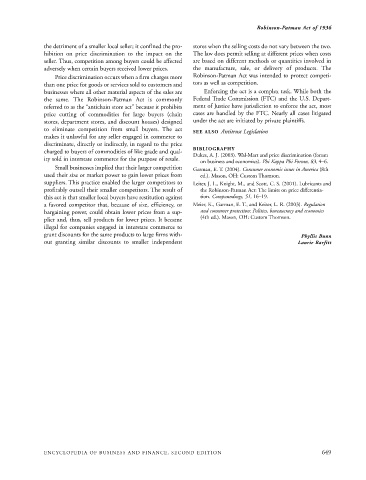Page 672 - Encyclopedia of Business and Finance
P. 672
eobf_R 7/5/06 3:20 PM Page 649
Robinson-Patman Act of 1936
the detriment of a smaller local seller; it confined the pro- stores when the selling costs do not vary between the two.
hibition on price discrimination to the impact on the The law does permit selling at different prices when costs
seller. Thus, competition among buyers could be affected are based on different methods or quantities involved in
adversely when certain buyers received lower prices. the manufacture, sale, or delivery of products. The
Price discrimination occurs when a firm charges more Robinson-Patman Act was intended to protect competi-
than one price for goods or services sold to customers and tors as well as competition.
businesses where all other material aspects of the sales are Enforcing the act is a complex task. While both the
the same. The Robinson-Patman Act is commonly Federal Trade Commission (FTC) and the U.S. Depart-
referred to as the “antichain store act” because it prohibits ment of Justice have jurisdiction to enforce the act, most
price cutting of commodities for large buyers (chain cases are handled by the FTC. Nearly all cases litigated
stores, department stores, and discount houses) designed under the act are initiated by private plaintiffs.
to eliminate competition from small buyers. The act
SEE ALSO Antitrust Legislation
makes it unlawful for any seller engaged in commerce to
discriminate, directly or indirectly, in regard to the price
BIBLIOGRAPHY
charged to buyers of commodities of like grade and qual-
Dukes, A. J. (2003). Wal-Mart and price discrimination (forum
ity sold in interstate commerce for the purpose of resale.
on business and economics). Phi Kappa Phi Forum, 83, 4–6.
Small businesses implied that their larger competition Garman, E. T. (2004). Consumer economic issues in America (8th
used their size or market power to gain lower prices from ed.). Mason, OH: Custom Thomson.
suppliers. This practice enabled the larger competitors to Leiter, J. L., Knight, M., and Scott, C. S. (2001). Lubricants and
profitably outsell their smaller competitors. The result of the Robinson-Patman Act: The limits on price differentia-
this act is that smaller local buyers have restitution against tion. Compoundings, 51, 16–19.
a favored competitor that, because of size, efficiency, or Meier, K., Garman, E. T., and Keiser, L. R. (2003). Regulation
bargaining power, could obtain lower prices from a sup- and consumer protection: Politics, bureaucracy and economics
plier and, thus, sell products for lower prices. It became (4th ed.). Mason, OH: Custom Thomson.
illegal for companies engaged in interstate commerce to
grant discounts for the same products to large firms with- Phyllis Bunn
out granting similar discounts to smaller independent Laurie Barfitt
ENCYCLOPEDIA OF BUSINESS AND FINANCE, SECOND EDITION 649

